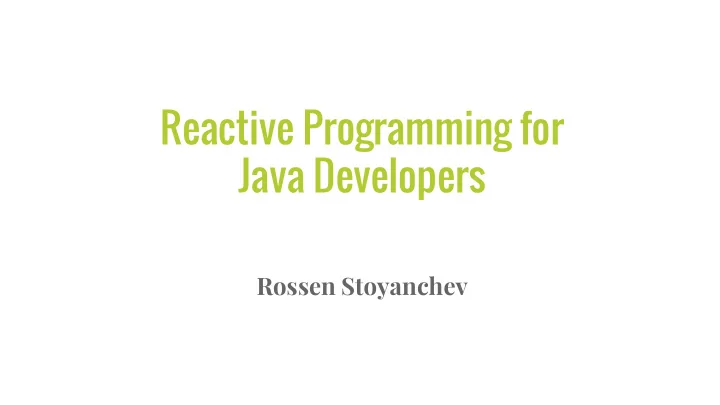

Reactive Programming for Java Developers Rossen Stoyanchev
About Me Spring Framework committer ❖ Spring MVC, WebSocket messaging ❖ Spring 5 Reactive ❖
Long-Running Shift to Concurrency
Today Independent services, Cloud environment, 10 years ago Distributed apps Self-sufficient apps, App server, Keep it simple, don’t distribute
Changing expectations Internet scale & resilience , Efficient use of resources, Latency is common
Impact on programming model Imperative logic not so simple when latency is the norm Forced to deal with asynchronicity Limits of scale
There is another way Fundamentally async & non-blocking Using very few threads Major shift but also major benefits
Reactive Programming?
In this talk How would we design an async API in Java ? Can we do better ? Introducing reactive libraries Spring reactive experience
Design async API in Java
Return one thing ... ...
Usage
Return it async style ... May occur in different thread
Usage Ugh
CompletableFuture (JDK 1.8) Future with actions ❖ Actions trigger when Future completes ❖ Callback mechanism ❖
Return it async style with Java 1.8 ... ...
Usage Async callback!
Usage Requires null check
Return many ... ...
Return many ... ... No callback till all users collected
Return many ... ... It may be too many
Return nothing ... ...
Return nothing ... ... Async notification: success or failure?
Can we do better?
Async results as a stream One notification per data item ❖ One notification for either completion or error ❖
Return Type Description Notifications Success void onComplete() Failure void onError(Throwable) Match User onNext(User), onComplete() No match User onComplete() Failure User onError(Throwable) Two matches List<User> onNext(User), onNext(User), onComplete() No match List<User> onComplete() Failure List<User> onError(Throwable)
Stream abstraction Functional, declarative programming model ➢ Combine, transform, reduce sequences ➢ Focus on what, not how ➢
Java 8 Stream Great example of the benefits of a stream API ➢ However built for collections mainly ➢ Pull-based, usable once ➢
Beyond collections Latency-sensitive data streams ➢ Infinite sequences ➢ Push-based notifications ➢
Reactive Libraries
Reactive library? Stream-like API similar to Java 8 ➢ Suited for any data sequence ➢ Latency-sensitive, infinite, collections ➢
Project Reactor Reactive Streams foundation for the JVM ➢ API similar to ReactiveX ➢ Easy to bridge to Java 8 Stream ➢
Flux -- sequence of 0..N
Mono -- sequence of 0..1
Flux to Java Stream
Mono to CompletableFuture
More than a stream API Reactor is back-pressure ready ➢ Reactive Streams spec ➢ Producers must not overwhelm consumers ➢
Reactive Streams Spec Industry collaboration ❖ Small API, rules, TCK ❖ Reactive interoperability across libraries ❖
Reactive Streams included in Java 9 “No single best fluent async/parallel API. CompletionStage best supports continuation-style programming on futures, and java.util.stream best supports (multi-stage, possibly- parallel) "pull" style operations on the elements of collections. Until now, one missing category was "push" style operations on items as they become available from an active source.“ Doug Lea, from initial announcement
Reactive Streams in Java 9 Interfaces in java.util.concurrent.Flow ❖ SubmissionPublisher ❖ standalone bridge to Reactive Streams Tie-ins to CompletableFuture and Stream ❖
Reactive Streams API public interface Publisher<T> { void subscribe(Subscriber<? super T> subscriber); }
Reactive Streams API public interface Subscriber<T> { void onSubscribe(Subscription sub); void onNext(T item); void onError(Throwable ex); void onComplete(); }
Reactive Streams API public interface Subscriber<T> { void onSubscribe(Subscription sub); void onNext(T item); void onError(Throwable ex); void onComplete(); }
Reactive repository
Using the reactive repository
Using the reactive repository Subscriber triggers flow of data
Using the reactive repository Consume all data by default
Output onSubscribe request(unbounded) onNext(User: Jason) onNext(User: Jay) ... onComplete()
Usage Consume two at a time
Output onSubscribe request(2) onNext(User: Jason) onNext(User: Jay) request(2) onNext(User: Joe) onNext(User: John) ...
More on Reactor Currently 2.5 M4 (might change to 3.0 label) ❖ GA release scheduled for July ❖ Hands-on exercise, blog post series ❖
Reactive Spring
Reactive Spring MVC ?
Annotated controllers
Controller Methods
Annotated controllers Spring MVC Spring Web Reactive
...
Mono<Object> ...
@MVC Spring MVC Spring Web Reactive Servlet API ???
@MVC Spring MVC Spring Web Reactive Servlet API ??? Servlet Container ???
@MVC Spring Web Reactive HTTP Servlet 3.1 Reactor I/O RxNetty Reactive Streams
Spring Framework 5.0 M1 spring-reactive
More Reactive Efforts
Reactive Journey
@rstoya05
Recommend
More recommend